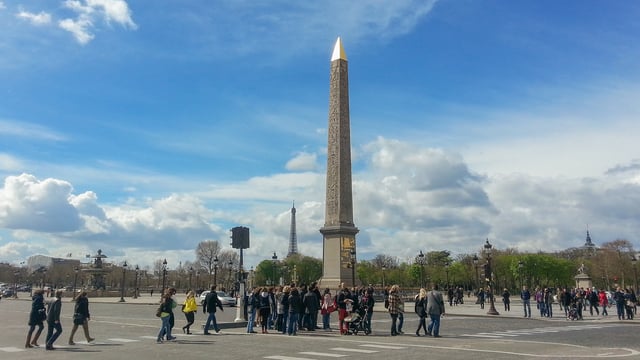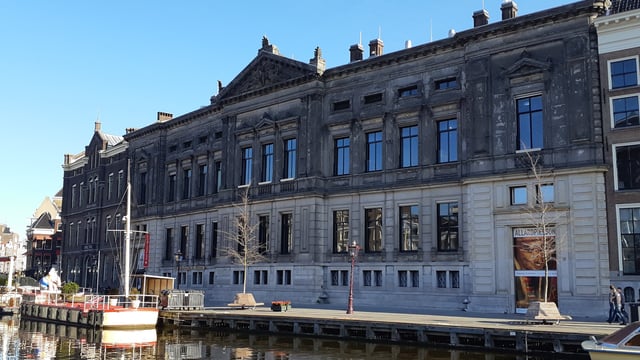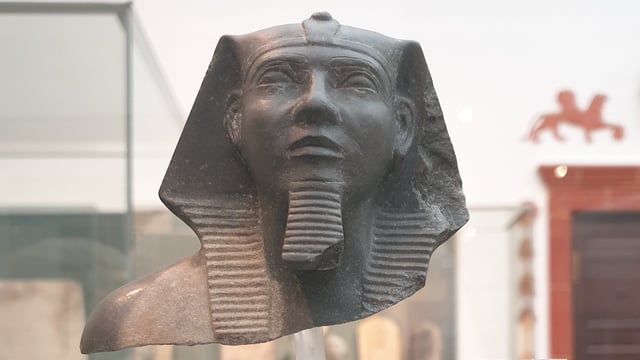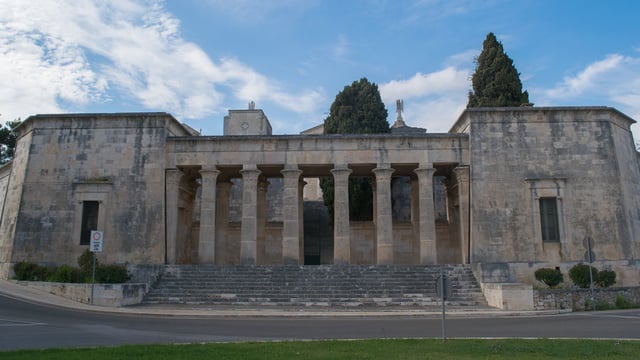Egyptomania
Ancient Egypt & Popular Imagination

Egypt: From Pharaonic Times to the Recent Past
Ancient Egypt Around the World
Arles Obelisk
An uninscribed obelisk made of red granite and brought to France from Egypt by Constantine I. Arles was one of Constantine’s favourite cities, and here he built baths and an impressive amphitheatre – so well preserved it is still in use today. The obelisk was placed on the spina of the circus – the remains of which can still be seen near the archaeology museum. In late antiquity the obelisk fell and broke in two. Rediscovered in 1389, it was later re-erected in the centre of the Place de la République by Louis XIV.

Cleopatra's Needle, London
Situated on the northern embankment of the Thames River in London is one of a pair of ancient obelisks that were erected in 1475 at the Egyptian city of Heliopolis by Thutmose III. The other now stands in Central Park, New York. In 12 BC the pair were moved from Heliopolis (Cairo) to Alexandria by Cleopatra. Sometime after 1200 AD when both were noted as still standing, the obelisk that was taken to London toppled. Suggestions are this was in 1303 when an earthquake off Crete brought down the Alexandria Lighthouse. The obelisk was erected in London in September 1878.

Cleopatra's Needle, New York City
Standing in New York’s Central Park is one of a pair of ancient obelisks that were originally erected in in 1475 at the Egyptian city of Heliopolis by Thutmose III. The other now stands on the banks of the Thames River, London. The obelisk was offered as a gift to the US at the opening of the Suez Canal in 1869. Since being in New York the surface of the obelisk have weathered significantly and some of the hieroglyphic inscriptions are barely visible. Thutmose had the first set of inscriptions added, and 200 years Rameses II added to these in commemoration of his military victories.

Deir el-Medina
On the West Bank of the Nile River at Luxor is the site of an ancient workmen’s village. It was here that workmen who were responsible for the construction o the tombs in the Valley of the Kings during the 18th to 20th Dynasties of the New Kingdom. These workmen knew the settlement as Set Maat, or the Place of Truth. In the Christian era the Temple of Hathor was converted into a Christian monastery. Hence the name Deir el-Medina, which means Monastery of the City in Arabic. The site was thoroughly excavated in the early 20th century, and as a result we have a one of the best documented records of community life from the ancient world. Besides the remains of the village, there are also the very well preserved painted tombs of the overseers of the artisans.


Egyptian Temple Debod
One of the main attractions in Parque del Oeste in the city of Madrid is an ancient Egyptian temple. Built in the 2nd Century BC by the Kushite king of Meroë, the temple was given to Spain in 1968 by the Egyptian government for Spain’s help in relocating the Abu Simbel temple before the construction of the Aswan dam. The re-construction in the Spanish capital was completed in 1972. Today the Temple is a part of a water feature in the Parque del Oeste. Although this setting nothing like its original location, it does allow wonderful photographic opportunities.


Giza Necropolis - Pyramids & Sphinx
Perhaps one of the most well known archaeological sites in the world. The site is a funerary complex for three ancient Egyptian kings. The site consists of three Pyramid Complexes, of kings Khufu, Khafre and Menkaure. The Great Pyramid was built for King Khufu, while the Great Sphinx of Giza was part of the Pyramid Complex of King Khafre. Of King Menkaure’s Pyramid complex, three smaller pyramids thought to have been for his wives have also survived. Visitors can take a quick, two or three hour guided tour of the highlights or spend a full day exploring the various aspects of the ancient necropolis.

Graeco-Roman Museum
Having closed to the public in 2005, the Graeco-Roman Museum in Alexandria re-opened on 13 October 2023. Established in 1892, the museum has been in its present neoclassical building since 1895. At first there were 11 galleries. The most recent gallery, the 25th, was added in 1984. Now one of the finest museums of its period, collections focus on the Greco-Roman (also known as the Ptolemaic) era of the 3rd century BC in Egypt. Highlights include a black granite sculpture of Apis, the sacred bull of the Egyptians, numerous mummies, sarcophagus, tapestries, and many other other objects of daily life that offer a view of ancient Greeks and Romans in contact with ancient Egypt.

Luxor Obelisk, Place de la Concorde
At the bottom of the Champs Elysées and set in the centre of one of the most well known traffic circles in the world stands an Egyptian obelisk from the Luxor Temple. The so-called Luxor Obelisk is made of red granite, measures 22.5 metres in height and weighs an estimated 227 tonnes. This obelisk and its pair, that still stands in front of the first pylon of the temple in Luxor, were the largest obelisks to have been erected by Ramses II; others were set up at temples in Heliopolis and Tanis. The obelisk arrived in France on 10 May 1833. And on 25 October the obelisk was raised watched on by King Louis-Philippe I and an eager crowd.


Sekhmet statue at Sotheby's, London
Above the entrance to Sotheby’s on Bond Street in London is a sculpture of an ancient Egyptian goddess carved in black diorite. The obvious feline features immediately identify her as Sekhmet. She was a warrior goddess and goddess of healing who was depicted as a lioness. Given we are used to seeing artefacts like this in museums, some think this is a replica, not an original artefact from Egypt. Sekhmet statues have their origin in the 18th Dynasty, during the reign of Amenhotep III. This example is thought to date to around 1320 BC.


Tribune Tower, Chicago
Tribune Tower is a 141 m skyscraper in downtown Chicago, with neo-Gothic features. It was home to the newspaper, Chicago Tribune. What is particularly interesting about the building is the collection of some 150 fragments of great buildings and historic monuments from around the world. These include pieces from the Great Pyramid in Giza, the Great Wall of China and the Notre Dame Cathedral in Paris, etc. Before the building was constructed correspondents for the Tribune would bring back fragments of buildings from their assignments around the world. These were then incorporated into the Tribune Towers when built between 1923 and 1925.

Museums with Egyptian Collections
Allard Pierson Museum
Focusing on the great civilisations of the ancient world, the Allard Pierson is the archaeological museum of the University of Amsterdam. Among its collections is much material from ancient Egypt, the Near East, and the Mediterranean, including a noted selection of classical Greek pottery and Roman sarcophagi. Also at the museum are a selection of rare books, cartographic material, and one of Europe’s largest Jewish collections.
The museum takes its name from a 19th-century clergyman who served as the university’s first professor of classical archaeology.

Art Institute of Chicago
Founded in 1879, the Art Institute of Chicago exhibits artistic traditions from around the World. With over 300,000 objects and over one million square feet, this is not only one of the leading art institutions in the United States of America, it is the second largest – following the Metropolitan Museum of Art in New York. Although an art museum with substantial collections of modern and contemporary art, there is also much of archaeological interest on display, in particular from Europe and Asia,


Arts & Crafts Museum Hamburg
One of Europe’s most important museums showcasing the applied arts, with arts and crafts, interior design and photography from Europe, Asia and the Middle East. The museum also has important collections of ancient Egyptian, Greek and Roman artefacts on display. Over 4,000 years of applied arts are displayed in galleries spread over three floors in a building that was intended to resemble a neo-renaissance palace. Some of the highlights include a 5th century BC krater from Apulia, Etruscan reliefs, the red Speigel Canteen and an example of the ‘New Frankfurt’ fitted kitchen.

Ashmolean Museum
Established in 1683 and with an international reputation, the Ashmolean Museum is the University of Oxford’s museum of art and archaeology. Having started life as the private collection of Elias Ashmole, who then donated it to the university, it was the world’s second university museum to open. The present building was erected in the 1840s and renovated in the 2000s. Its collections are diverse, comprising material from ancient Egypt to early medieval England, and contain many famous objects, like the Alfred Jewel and Oliver Cromwell’s death mask.

Besançon Museum of Fine Arts and Archaeology
Opened in 1694, the musée des beaux-arts et d’archéologie de Besançon is the oldest public museum in France, almost a hundred years older than the principal French museums. Through substantial donations of local and European archaeological artefacts and paintings and drawings by well known French and European artists, the museum displays an impressive collection of Europe’s cultural heritage.

Bristol Museum & Art Gallery
The Bristol Museum and Art Gallery is housed in a glorious Edwardian building and contains 19 galleries across 3 floors. The exhibitions comprise natural history, art, archaeology and geology from around the world. The ground floor contains the Archaeology and World Cultures collections, with a play and learn space for under 7’s. The first floor ‘wows’ with geology, dinosaur and wildlife galleries – the second floor hosts art galleries.

Chrysler Museum of Art, Norfolk
Over 30,000 objects represent some 5,000 years of World history. Contemporary and modern American and European arts make up the core of the Chrysler Museum of Art’s collection, but it also has artefects from the ancient world, Asia, Africa, and Pre-Columbian America (notably a large collection of Maya ceramics) that are well worth seeing. About a third of the museum’s collection is made up of glass objects, spanning 3,000 years – making this one of the largest collections of glass in the World. The museum is open everyday of the week except Mondays, and general admission is free of charge.

Egypt Centre
The Egypt Centre is a university museum with over 4,500 artefacts, the majority are Egyptian but also a few Classical pieces. Most of these come from the immense collection of objects amassed by the pharmacist Sir Henry Wellcome. Artefacts range from carved stone fragments to painted linen shrouds. Among the many highlights are over 200 objects from the city of Amarna, and two pieces of a stone sarcophagus which belonged to Amenhotep.

Egyptian Museum of Turin
Jean-François Champollion, the French linguist who was the first to decipher Egyptian hieroglyphs, wrote “The road to Memphis and Thebes passes through Turin”. One of the reasons for this reputation is because the Egyptian Museum of Turin has the second largest collection of Egyptian antiquities in the world (after the museum in Cairo). The first object from Egypt arrived in 1630, after which there were many campaigns to Egypt. The museum has the oldest known example of the Egyptian Book of the Dead.

Egyptology Museum, University of Leipzig
Housed in what was a private bank built in the 1920s, the Krochhochhaus, is the Egyptological Institute of Leipzig University’s Ägyptisches Museum – Georg Steindorff. An important collection of over 7,000 artefacts from Egypt and Sudan that starts with prehistory cultures and ends in the early Islamic period of the area. One of the highlights on display is the richly decorated sarcophagus of Hedbastiru; the object that would give rise to the establishment of the museum.


Egyptian Revival Architecture Around the World
Alberobello Monumental Cemetery
Built in 1887, the monumental entrance to the city of Alberobello’s cemetery was inspired by funerary architecture of ancient Egypt. What you see today, however, is only a portion of what was planned. Lack of funds prevented the ambitious project being completed. The entrance hall with its 12 columns, the capitals given a typical ancient look of lotus flowers, are flanked by two chapels. Various architectural features are highly decorated with ancient Egyptian iconography.

Bartholomew Cemetery Catacombs, Exeter
Located in the Bartholomew Cemetery, the catacombs were built between 1835 and 1837 up against the city walls. The cemetery was the first in Britain to be constructed using public funds. Also, the use of Egyptian style architecture for the entrances is the first instance of Egyptian revivalism in a British cemetery. As a venture, the catacombs were a failure as it was too costly for most. When the cemetery closed in 1946 only 11 people had been interred.


Highgate Cemetery
There are few burial places in London, or even the whole of Britain, that are as famous and evocative as Highgate Cemetery. Established in the early years of Queen Victoria’s reign, the site is known for its elaborate Neo-Gothic tombs, foreboding mausoleums, and sculpted stone angels. Egyptian revivalist architecture can be found in the Egyptian Avenue. The cemetery spreads across fifteen hectares on a hill to the north of the city. Among the 170,000 people laid to rest here are many famous figures who made their names in politics, sport, and the arts.


Reebie Storage Facility, Chicago
Colourful and bold, the façade of the Reebie Storage Warehouse is unmistakeably Egyptian in influence. And the attention to detail is striking. As one of the finest commercial uses of Egyptian revival architecture in the USA, the building is listed on the National Register of Historic Places (1979) and is a designated Chicago Landmark (1999).
The storage facility was completed in 1922, only months before the opening of Tutankhamun’s tomb in Egypt. So it was Ramses II that was used as the model for the two Egyptian men on either side of the entrance, which represent the two founders of the company John and William Reebie.




























